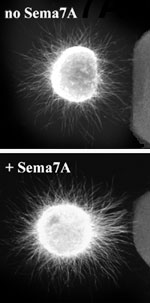New growth-stimulating cue identified for nerve cells

Bathed in nutrients, but in the absence of any particular cue, axons will extend from cortex nerve cells in all directions (top image). Toss in a growth stimulator like semaphorin-7a, and axon growth is heavier nearest the cue (bottom image). Credit: Johns Hopkins Medical Institutions, Nature. <br>
For decades, scientists have hunted for signals that guide nerve cells’ tentacle-like axons, hoping to understand how these cell tips reach out to distant targets. It’s knowledge that might one day help researchers learn how to rebuild nerves lost to spinal cord injuries or diseases like Huntington’s.
Now, a Johns Hopkins team studying a family of proteins best known for repelling axons and inhibiting their growth reports finding one member that unexpectedly promotes axon growth instead. In their experiments, rat nerves in the lab grew more and longer axons on the side nearest a source of this protein, called semaphorin-7a. Moreover, in mice without semaphorin-7a, axons of some odor-sensing nerve cells never reached their targets, the scientists report in the July 24 issue of Nature.
“I’ve been studying semaphorins for about a decade and didn’t expect to find any that stimulated axon growth, certainly not to the extent we saw in the lab and in mice,” says Alex Kolodkin, Ph.D., professor of neuroscience in The Johns Hopkins University School of Medicine’s Institute for Basic Biomedical Sciences. “Now we need to figure out how semaphorins balance their repulsive and attractive effects.”
Part of the answer to this paradox, Kolodkin says, is that semaphorin-7a interacts with different proteins than its relatives. In experiments with rat nerve cells involved in sensing odors, first author and postdoctoral fellow Jeroen Pasterkamp, Ph.D., found that semaphorin-7a spurs axon growth by hooking onto proteins called integrins, which are found on nerves and many other cell types.
Among their many roles, integrins (pronounced IN-teh-grins) help control cells’ interactions with their surroundings by capturing chemical signals and conveying the messages to cells’ internal machinery. Even though this is the first report to link semaphorins and integrins, both protein families are rapidly being recognized as major contributors to neurological function and disease, says Kolodkin.
“Because integrins are important throughout the body, targeting them to stimulate axon growth or re-growth in a particular area of the brain or spinal cord presents many problems,” notes Pasterkamp. “Our next steps are to find out exactly how semaphorin-7a’s message is passed along inside the nerve, which will hopefully reveal a useful, specific target for promoting axon growth following nerve injury or degeneration.”
As the researchers learn more of the specifics about how semaphorin-7a differs from its relatives, they also hope to redraw their picture of how semaphorins as a family affect nerve development throughout life, they say.
Media Contact
All latest news from the category: Life Sciences and Chemistry
Articles and reports from the Life Sciences and chemistry area deal with applied and basic research into modern biology, chemistry and human medicine.
Valuable information can be found on a range of life sciences fields including bacteriology, biochemistry, bionics, bioinformatics, biophysics, biotechnology, genetics, geobotany, human biology, marine biology, microbiology, molecular biology, cellular biology, zoology, bioinorganic chemistry, microchemistry and environmental chemistry.
Newest articles

A universal framework for spatial biology
SpatialData is a freely accessible tool to unify and integrate data from different omics technologies accounting for spatial information, which can provide holistic insights into health and disease. Biological processes…

How complex biological processes arise
A $20 million grant from the U.S. National Science Foundation (NSF) will support the establishment and operation of the National Synthesis Center for Emergence in the Molecular and Cellular Sciences (NCEMS) at…

Airborne single-photon lidar system achieves high-resolution 3D imaging
Compact, low-power system opens doors for photon-efficient drone and satellite-based environmental monitoring and mapping. Researchers have developed a compact and lightweight single-photon airborne lidar system that can acquire high-resolution 3D…





















